By Christopher Horner in Human Events
In his February 24 speech, President Obama asked Congress to send him “legislation that places a market-based cap on carbon pollution and drives the production of more renewable energy in America.” But by “market-based cap” he means that the government would mandate carbon dioxide emission permits - which are essentially permits to use energy - that companies would then be able to sell among themselves.
His budget assumes a staggering $650 billion in revenue from this scheme. But who picks up the tab? Who ultimately pays the cost of buying these slices of global warming baloney, and why would industry support such a scheme? The answer is that you and I do, as does everyone who buys anything requiring energy, just like we pay the cost of all the other taxes paid by manufacturers. It’s a tax, folks. Plain and simple, Obama’s “market-based cap” plan is a tax on American business.
Industry is actually behind this massive tax, having sold their support so that the tax is not merely passed through to consumers, but it allows companies to skim the scheme for a profit, again at your expense. This tax, however, is nearly twice the size of the failed BTU tax which Al Gore still attributes the Democrats’ loss of Congress the next year.
The BTU tax was offered in the name of deficit reduction. Obama’s global warming tax is expressly to pay for new middle-class welfare entitlements, even though it takes away from the beneficiaries about the same amount they will fork out in increased energy costs (if not the entire inflationary impact). The important point for his movement, however, is that more money is run through the state, creating dependency.
With BTU, the then-new “rock star” Democratic president Clinton was rebuffed by a Democratic Congress once the public fought back. This was only after the House had passed the tax by one vote - cast by Rep. Marjorie Margolies Mezvinsky (D-PA), who tearfully marched down to change her vote after being singled out for flipping by the White House. As she shuffled back up the aisle, a prescient Republican caucus loudly waived “bye, Margie!” knowing the gift she had given them. She was among many BTU-tax supporters later driven from office.
Then business successfully “Swiss-cheesed” the tax proposal by lobbying and achieving so many carve-outs that the tax simply collapsed. With an insufficient business constituency, Democratic Sens. Bennett Johnston, John Breaux and David Boren could not justify so angering the public and instructed the new president how the world would work. There are two lessons here.
First, as Al Gore confessed to the Financial Times, going through the front door of a direct energy tax is too risky. Hence the cap-and-trade rationing scheme; it’s a tax but a non-transparent one, also making it vastly less efficient (more expensive) according to economists at, for example, the Congressional Budget Office. The message to lawmakers is to worry about one job: yours. Hide the tax. The part about also doubling the tax seems to be all Obama’s idea.
Second, cap-and-trade shows that business has also learned how to sell its support in return for additional schemes to further pick your pocket, siphoning of some of the cost to themselves. Cap-and-trade provides them billions of your dollars in return for playing along. Read more of this powerful must read here.
On this Watts Up With That post here, about today’s snowy frigid “global warming protest” in DC, manacker (15:44:12) commented
Thingsbreak wrote: “Nothing is going to satisfy people who believe 7 mutually contradictory things about climate change.”
What could this sentence mean?
Let’s look at some IPCC “contradictions” (areas where the observed facts contradict the IPCC claims):
Contradiction #1:
IPCC projects global warming at a rate of 0.2C per decade in the early 21st century; so far the first 8 years of the 21st century have shown cooling at an average rate of around 0.1C per decade. Oops!
Contradiction #2:
IPCC states that the rate of sea level rise has increased in the latter part of the 20th century, switching from tide gauge records to satellite altimetry; the tide gauge record shows a slight decrease in sea level rise in the second half of the 20th century, as compared to the first half. Hmm.
Contradiction #3:
IPCC states that changes in solar irradiance since 1750 are estimated to cause a radiative forcing of only 0.12 W/m2, equivalent to a net warming of around 0.02C; several studies by solar scientists conclude that the 20th century warming caused by the unusually high level of solar activity is around 0.35C. Ouch!
Contradiction #4:
IPCC states that the warmth of the last half century is unusual in at least the previous 1,300 years, ignoring overwhelming physical and historical evidence of a warmer global Medieval Warm Period. Huh?
Contradiction #5:
IPCC claims that the satellite temperature record has shown a faster rate of tropospheric warming than that at the surface, confirming the anthropogenic cause of warming; both the satellite and radiosonde record show less warming than the surface record. Oops!
Contradiction #6:
IPCC models all assume a strongly positive feedback from clouds with warming, resulting in 1.3C of the total assumed 2xCO2 climate sensitivity of 3.2C; actual physical observations show a strongly negative net feedback from clouds of around the same order of magnitude; correcting the 2xCO2 climate sensitivity for this factor brings it to around 0.6 to 0.8C, rather than 3.2C. Ouch!
Contradiction #7:
IPCC states confidently that the upward distortion of the surface temperature record due to the urban heat island effect has a negligible influence of less than 0.006C per decade; many studies from all over the world show that the UHI influence is thirty to fifty times as great as claimed by IPCC. Oh, oh!
There are many more, but I’ll just list these seven to start with.
Max
Often when I or any other skeptic are quoted in a newspaper, do a TV interview that is carried on the station’s or network’s web site or get mentioned in an alarmist blog, the first knee jerk reactions of some commenters is to accuse us of being part of some far right wing conspiracy to preserve the status quo (many of us are independent or even left of center politically - it is not about politics but about science) and continue our polluting ways (CO2 is not a pollutant but a plant fertiilzer), or most commonly of being a shill for big oil, or dirty from coal, or bought and paid for by the fossil fuel industry. That is clearly not the case.
Compared to the proponents riding the big grant money gravy train we are the person on the corner with a tin cup. Marc Morano did a comparison of the funding received by the proponents in comparison to the smaller funding for objective scientists who take a more skeptical or open minded position (the way science used to be before the lure of money corrupted it). Marc did not include the funding the alarmists blogs get from folks like George Soros, Fenton Communications, convicted Canadian felons, environmental groups and activists which runs in the many millions of dollars. Here is Marc’s summary. You may have other examples. If so please email me (jdaleo@icecap.us).
Paleoclimate scientist Bob Carter, who has testified before the Senate Environment & Public Works committee, explained how much money has been spent researching and promoting climate fears and so-called solutions. “In one of the more expensive ironies of history, the expenditure of more than $US50 billion on research into global warming since 1990 has failed to demonstrate any human-caused climate trend, let alone a dangerous one,” Carter wrote on June 18, 2007. (LINK)
The U.S. alone has spent $30 billion on federal programs directly or indirectly related to global warming in just the last six years, according to one estimate. (LINK) ($5.79 billion in 2006 alone). Adding to this total is funding from the UN, foundations, universities, foreign governments, etc. Huge sums of money continue to flow toward addressing climate fears.
Even if you factor in former Vice President Al Gore’s unsubstantiated August 7, 2007 assertion that $10 million dollars a year from the fossil fuel industry flows into skeptical organizations, any funding comparison between skeptics and warming proponents utterly fails. Gore launched a $100 million a year multimedia global warming fear campaign. Gore alone will now be spending $90 million more per year than he alleges the entire fossil fuel industry spends, according to an August 26, 2007 article in Advertising Age. (LINK)
Meteorologist Dr. Roy W. Spencer, formerly a senior scientist for climate studies at NASA’s Marshall Space Flight Center and currently principal research scientist at the University of Alabama in Huntsville, “Of course, the vast majority of mainstream climate researchers receive between $100,000 to $200,000 from the federal government [to conduct research in] support of manmade global warming,” Spencer wrote in an August 15, 2007 blog post. (LINK)
James Spann, a meteorologist certified by the American Meteorological Society, suggests scientific objectively is being compromised by the massive money flow to proponents of man-made climate fears. “Billions of dollars of grant money is flowing into the pockets of those on the man-made global warming bandwagon. No man-made global warming, the money dries up. This is big money, make no mistake about it. Always follow the money trail and it tells a story,” Spann wrote on January 18, 2007. (LINK) “Nothing wrong with making money at all, but when money becomes the motivation for a scientific conclusion, then we have a problem. For many, global warming is a big cash grab,” Spann added.
The well-heeled environmental lobbying groups have massive operating budgets compared to groups that express global warming skepticism. The Sierra Club Foundation 2004 budget was $91 million and the Natural Resources Defense Council had a $57 million budget for the same year. Compare that to the often media derided Competitive Enterprise Institute’s small $3.6 million annual budget.
In addition, if a climate skeptic receives any money from industry, the media immediately labels them and attempts to discredit their work. The same media completely ignore the money flow from the environmental lobby to climate alarmists like James Hansen and Michael Oppenheimer. (ie. Hansen received $250,000 from the Heinz Foundation and $500,000 from the David Foundation and Oppenheimer is a paid partisan of Environmental Defense Fund)
The most repeated accusation is that organizations skeptical of man-made climate fears have received $19 Million from an oil corporation (ExxonMobil) over the past two decades. To put this $19 Million over two decades into perspective, consider: One 2007 U.S. Department of Agriculture (USDA) grant of $20 million to study how “farm odors” contribute to global warming exceeded all of the money that skeptics reportedly received from an oil giant in the past two decades. To repeat: One USDA grant to study the role of “farm odors” in global warming exceeded ALL the money skeptics have been accused of receiving from an oil giant over the past two decades. (Excerpt from article: “The United States Department of Agriculture has released reports stating that when you smell cow manure, you’re also smelling greenhouse gas emissions.” (LINK)
By Roger Pielke Jr. Prometheus
Joe Romm has a post up today criticizing me as only Joe Romm can. It is full of misinformation and inaccuracies. I thought I’d open up a thread for anyone to ask direct questions of me, if they have any, in response to Romm’s llegations.
Let me say unequivocally, the following things:
1. Gore was right to admit that the slide was problematic and then pull it from his talk.
2. Gore has continuing problems using the Munich Re slide to make the same point.
3. Munich Re has published in the peer reviewed literature arguing that attribution of disasters to GHGs is not possible at this time, most recently last week.
4. An expert workshop that I co-organized with Munich Re concluded the same thing (PDF), and the results were published in Science (PDF).
5. There are no peer-reviewed papers documenting a link between GHG emissions and the long-term trend in disasters.
6. In the United States extreme events have actually declined over the long-term, not increased.
7. I will not parse the meaning of the word “this” as Joe Romm wants to do. The science on this subject is clear and unambiguous.
8. I have been banned from Joe Romm’s blog, so I cannot post this link there, so if a reader would do so, I would be obliged.
I trust that readers can see what Joe says, see what I say, and come to their own informed judgments about what to believe. If you have any questions, please ask me. I am perfectly happy to discuss any and all aspects of this issue, including the various technical details of the many peer-reviewed research papers that I have on this subject. See Roger Jr.’s post here.
Skeptical Meteorologist and State Representative Jim Ott Launches Weekly Report on Global Warming
By Rep Jim Ott, Wisconsin
Meteorologist and State Representative Jim Ott announced today that he will be releasing a weekly report on global warming. “The amount of material on global warming is so overwhelming,” said Ott, “that as a service to our readers I will be highlighting some of the more interesting global warming developments. This will be especially important as attempts to introduce global warming legislation in Wisconsin are expected in the near future.”
In this inaugural issue we will review some of the outrageous and possibly dangerous ideas of those who feel we must “fight” global warming now. Last April, Science magazine online reported that a proposed plan to inject sulfur compounds into the atmosphere in an attempt to mimic volcanic activity could actually damage the Earth’s ozone layer. The particles would supposedly block sunlight in an effort to cool the Earth’s temperature. As far as we know, there are no immediate plans to actually conduct such an experiment.
In January, it was reported that a group of scientists from Germany and India spread six tons of iron sulphate powder over a 100 square mile area of the Antarctic Ocean. This experiment was done in an attempt to cause a massive algae bloom. These scientists believe the algae will remove carbon dioxide from the air and then sink to the bottom of the ocean.
Did anyone conduct a comprehensive environmental impact assessment? How might clogging the oceans with algae affect marine life? How much of the oceans would the researchers want to ultimately treat if they felt their experiment was a success? What other effects might iron sulphate have on the environment? Apparently the answers to these questions don’t matter if you are fighting global warming.
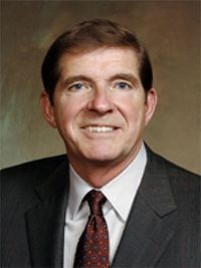
As a high school student in the 1960’s, I recall writing a term paper that questioned some of the outlandish ideas of how man might control the weather. The concern then was that the Earth was cooling, so schemes such as spreading coal dust over the arctic snow pack to melt it earlier in the spring, and orbiting large mirrors in space to reflect more sunlight to the earth were proposed. Today, some suggest orbital mirrors to actually deflect sunlight away from the Earth.
As far as we know, such warming experiments were never conducted as climate scientists began to accept that changing one part of the Earth’s climate could have unforeseen consequences in other areas. Unfortunately, these sorts of plans have now returned. If the algae experiment is any indication, global warming proponents are willing to try anything in their hysterical fear the planet is warming.
As a meteorologist, I oppose any attempts to alter the Earth’s climate with experiments that will be ineffectual at best and dangerous at worst. The United Nations should act immediately to stop this nonsense and individual nations should show respect for the Earth’s climate system, about which science still has a lot to learn. I will keep you informed as similar ideas are proposed. In next week’s edition: Is there really scientific consensus when it comes to global warming?
See first report here.
By Justin Berk, The Weather Examiner
Do you wonder if this Global Warming thing has been spun out of control by the media and now politicians? Are you a skeptic about the human influence on something you believe is a natural process? Or for that matter, perhaps Earth’s climate might actually be cooling?
Over 31,000 American scientists have signed a treaty saying, “Global warming poses no crisis to Earth”. At least in terms that this process is natural and something the planet has experienced before.
Stuart Chase (1888-1985), an American economist and engineer trained at MIT, is famous for writing the following statement:
“For those who believe, no proof is necessary. For those who don’t, no proof is possible.”
Chase was the originator of the expression a New Deal, which became identified with the economic programs of President Franklin Delano Roosevelt. So it is fitting that this concept applies to today’s economic and political digression. Our congress just approved the $787 Billion ‘stimulus bill’. It is largest spending spree in history, and it also contains billions of dollars diverted to programs based on combating climate change. Money that many scientists and economists say will be wasted. Don’t get me wrong. Conservation is good. Improving efficiency and controlling waste is good. Exploring alternative energy is also good. But too many questions are still left undebated.
So is it that simple, or should it be? Is the human influence on climate change just a black and white issue? Believe or be a denier? According to the foundations of the scientific method: A theory must continue to be tested. When it is proven, then it becomes law. No law has been stated with climate change!
The purpose of this post is to inform you about a conference next month in New York City. Watch the video and please share your thoughts. I will continue to provide more information in the next few days with support to continue the discussions and scientific debate. Read more here.
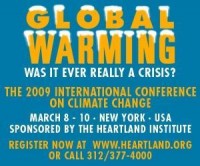
By Julian Glover, UK Guardian
‘Roll up for the great pollution fire sale, the ultimate chance to wreck the climate on the cheap. You sir, over there, from the power company - look at this lovely tonne of freshly made, sulphur-rich carbon dioxide. Last summer it cost an eyewatering 31 pounds to throw up your smokestack, but in our give-away global recession sale, that’s been slashed to a crazy 8.20 pounds. Dump plans for the wind turbine! Compare our offer with costly solar energy! At this low, low price you can’t afford not to burn coal!”
Set up to price pollution out of existence, carbon trading is pricing it back in. Europe’s carbon markets are in collapse. Yet the hiss of escaping gas is almost inaudible. There’s no big news headline, nothing sensational for TV viewers to watch; no queues outside banks or missing Texan showmen. You can’t see or hear a market for a pollutant tumble. But at stake is what was supposed to be a central lever in the world’s effort to turn back climate change. Intended to price fossil fuels out of the market, the system is instead turning them into the rational economic choice.
That there exists something called carbon trading is about all that most people know. A few know, too, that Europe has created carbon exchanges, and traders who buy and sell. Few but the professionals, however, know that this market is now failing in its purpose: to edge up the cost of emitting CO2. The theory sounded fine in the boom years, back when Nicholas Stern described climate change as “the biggest market failure in history” - a market failure to which carbon trading was meant to be a market solution. Instead, it’s bolstering the business case for fossil fuels.
Understanding why is easy. A year ago European governments allocated a limited number of carbon emission permits to their big polluters. Businesses that reduce pollution are allowed to sell spare permits to ones that need more. As demand outstrips this capped supply, and the price of permits rises, an incentive grows to invest in green energy. Why buy costly permits to keep a coal plant running when you can put the cash into clean power instead?
All this only works as the carbon price lifts. A lot of the blame lies with governments that signed up to carbon trading as a neat idea, but then indulged polluters with luxurious quantities of permits. The excuse was that growth would soon see them bumping against the ceiling.
Instead, exchanges are in meltdown: a tonne of carbon has dropped to about 8 pounds, down from last year’s summer peak of 31 pounds and far below the 30-45 pounds range at which renewables can compete with fossil fuels.
The lesson of the carbon slump, like the credit crunch, is that markets can be a conduit, but not a substitute, for political will. They only work when properly primed and regulated. Europe hoped that the mere creation of a carbon market would drive everyone away from fossil fuels. It forgot that demand had to outstrip supply, and that if growth stops, demand drops too.
There is not much time to rescue the system. Carbon trading remains at the heart of the international response to climate change. Obama backs what Americans call cap and trade. Australia wants to try the same thing. It should be at the heart of a deal at the Copenhagen summit this winter. But both are hesitating, given Europe’s mess.
The market must be unashamedly rigged to force supply below demand. The obvious way would be to cut the number of permits in circulation, but in a recession no government will be brave enough to do that. And private initiatives such as Sandbag, which encourages individuals to buy and lock away permits, can exert little pressure on price in a market awash with them.
Europe can choke off tomorrow’s supply, however, without hitting business today. First the EU must stop importing permits from countries such as Russia - a bonus for a paper transaction. No one really believes that 15m tonnes of imported permits will not still be emitted by a steelworks somewhere east of Novosibirsk. Second, it must publish plans to crack down on the surplus of permits when the recession is over. Warnings of famine ahead, when the scheme enters its third stage in 2012, would raise prices now, if believed. Like medieval pardoners handing out unlimited indulgences, governments have created a glut. Reformation must follow. Wanted - a modern Martin Luther to nail a shaming truth to industry’s door: Europe’s whizz-bang carbon market is turning sub-prime. Read story here.
By Michael Scott, Cleveland Plain Dealer
This may not play well in Northeast Ohio, but federal climate officials this week reported that planet Earth just had its seventh-warmest January in more than 125 years of records.
That’s right, even though Cleveland just finished 6.5 degrees colder than normal (remember that 13-below-zero day?), most of the rest of the world got hotter last month—including Australia, where records were broken with one 114-degree day.
The most recent report from the National Climatic Data Center in North Carolina asserts that the combined global land and ocean surface temperature for January was 54.55 degrees Fahrenheit—or 0.95 degrees above the 20th-century average temperature.
But in Cleveland—where we endured nine January days in the single digits or below zero and nearly set a snow record for the month—something may seem out of whack.
Does this mean we can’t even catch a break from global warming? “We were just at the wrong end of things in January,” said Ohio climatologist Jeff Rogers of Ohio State University. “The atmosphere largely carries spells of unusually cold and unusually warm weather in waves, and we were caught in a cold one.
“But that’s all it means—you can’t really look at one event, or one month, and say it’s proof of global warming or that global warming doesn’t exist, but plenty of people are trying.” Stu Ostro, director of communications for the Weather Channel, agreed. “The key word, as always, is context,” Ostro said.
“The map put out by NOAA [the National Oceanic and Atmospheric Administration] says it better than any words can tell: Cleveland, the state of Ohio and much of the eastern part of the U.S. had a cold January—but take a look at the rest of the world.”
Or even just the United States. Despite Northeast Ohio’s efforts to drive the numbers down, temperatures for the contiguous United States were slightly above the long-term average, about 0.4 degrees above the January average of 31.2 degrees.
Still, Northeast Ohio wasn’t the only cold spot in a warming world: Snowstorms swept across northern and eastern Europe and reached as far south as Spain and northern Italy. The United Kingdom experienced some of the lowest temperatures in 15 years. And snow cover, based on satellite observations, was near average across North America (6.8 million square miles) and Eurasia (11.3 million square miles) compared with the last 40 years of data. Read more here.
Icecap Note: As shown here, NOAA data suffers from major station dropout (75% of the worlds stations dropped in 1990 most of them high latitude rural and thus the colder stations), a ten fold increase in missing data, poor instrument siting (841 of the 1221 US stations evaluated by surfacestations.org in the last 18 months - only 11% met government standards with 89% with improper siting leading to excess warmth), use of instruments with warm bias not adjusted for, and most importantly NO adjustment for urbanization (which as you know produces the urban heat island). For all these reasons, you can pretty much discard the NOAA data for the world and for that matter the US where in their latest version of the USHCN data, they removed the urban adjustment. Look what that does for the temperatures versus the GISS US data which maintains a UHI adjustment based on night lights.
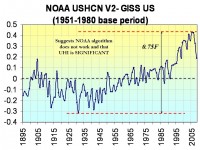
Comparison of the new USHCN to the GISS USHCN shows the NOAA version has increased the warming relative to the GISS by 0.75F since 1930.
GISS’s global adjustments are yet another issue as Steve McIntyre/Ken Gregory showed in my analysis here. The only reliable source for global data is the satellite which had January globally as the 8th warmest but in 30 years with a cold northern US, parts of Europe, northern Australia, Brazil and parts of Siberia but warmth in southern Australia, Argentina, parts of Russia, China and the southwestern US.
By Dr. Arthur Robinson in Human Events
A hidden effect of the November 4 elections and the national events that preceded them during this past year is perhaps best called the “John Galt Effect” in honor of Ayn Rand’s famous character in Atlas Shrugged. It is occurring to a very significant extent.
Our technological civilization stands upon the shoulders of many generations of free Americans and the great accomplishments that they bequeathed to us. Among those Americans and their counterparts in other countries have been a small special group of people whose unusual genius, work ethic, and love for their specialties were especially outstanding. These men, by their examples, their creations, and their leadership of free enterprises, have led our civilization upward. One of the greatest privileges of my life has been to know a few such people.
Without this small group of people, the technological attainments of their generations would not have taken place. We know the names of a few of them, but there were many more—constituting perhaps one person in a thousand. Ayn Rand called these people the “men of the mind.” In Atlas Shrugged, under the leadership of John Galt, they withdrew their services. They would only work in freedom. They would not work under tyranny.
In reality, most men of the mind never withdraw. They love their work too much to stop and—most of them—love their fellow men too much to desert them. The forces of tyranny depend upon this. Without these people, even the small technological advances required by Marxist and Socialist societies would not occur. Yet, while the men of the mind do not fully withdraw, they have families and other loved ones for whom they are responsible and to whom they are more devoted than to the state.
As the pendulum of politics now swings toward tyranny in the United States and dangers to those whom they love increase, these men and women partially turn their talents more toward their personal responsibilities. Part of their thoughts, efforts, and ingenuity are lost to society—and this loss cannot be recovered by either negative or positive incentives.
Throughout our country today, the men of the mind (women, too) are watching the awful scene in Washington and its reflection in state and local capitals throughout the United States. They understand the consequences of the government oppression that has dogged their own footsteps for many years and that will grow much worse in the near future. So, they are taking actions to protect themselves and their families. We have no way to measure the societal effects of this distraction of the men of the mind. There are immediate effects upon our well being and long term effects from the things that they are no longer working full time to create.
What is the cost of the distraction of our real leaders—of the men of the mind—of the John Galts among us? I estimate that it is greater than the trillions of dollars being lost on government printing presses. Call this Y2009K—and this time it is very real.
Our existing power plants are still operating; our petrochemical plants are still producing; our military defense is still performing; our food supplies are still flowing; and the rest of the technological infrastructure upon which our lives depend is largely still in place. But the key people—not those we see but those we do not see because they are constantly engaged in real work—are seriously distracted and now partially engaged in personal survival.
Of one thing we can be certain. When the essentials of our civilization begin to seriously falter and this causes real harm, those who would be our masters and their fellow travelers in the media, academia, business, and politics will cast blame upon some of these men of the mind—and drag them before us for punishment. Our John Galts know this, too, and it is a further distraction for them.
Some of these people are leading great enterprises. Others are in the basements of our power plants and other heavy industries. Some are closeted away in universities quietly at work on the next generations of possible advances in science and engineering. They are easily recognized—by their genius and by the love of their work that permeates their whole beings.
One way to recognize them is that they constantly talk about their work to anyone who will listen. Now they are distracted.
What are they talking about today? See this and other Arthur Robinson posts and intereesting comments here. Aurthur is one of the keynote presenters at the Heartland ICCC.
Heavy Snows Across Europe
By Patrick Thorne, http://www.skiinfo.com
Up To 2m of New Snow In Seven Days for Austria And Switzerland
It is still snowing heavily in Austria, German and Switzerland with many resorts receiving more than a metre of new snow in the past week. Switzerland had the largest falls of all with Sorenberg reporting an incredible 210cm (seven feet) of snow falling in the past seven days (the biggest fall of 60cm/two feet yesterday, February 17th). St-Cergue La Dole came close with 200cm (6.6 feet), 50 cm of which also fell yesterday. Zermatt continues to have the biggest snow depth in Europe and probably the world with 7.12m (24 feet) on the glacier.
In Austria the greatest snowfall of the past week has accumulated at the Zugspitzplatt Ehrwald which reports 135cm (over four feet) of new snow. Salbach Hinterglemm Leogang added 80cm (nearly three feet); the SkiWelt (including Söll and Going) 70cm (over two feet) and St. Anton am Arlberg 55cm (nearly two feet). The Kleinwalsertal area on the boarder between Austria and Germany received 65cm (Over two feet) of new snow in the past week, which according to Ralf Koberle of Kleinwalsertal Tourismus is, “Natural snow of the best quality - so our snowmakers take a break.” The resorts with the most snow in the country now have nearly four metre (13 feet) depths.
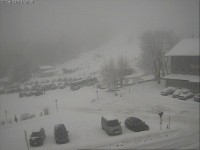
Germany had loads of fresh snow, too. The number of resorts that have a snow base of more than a metre doubled in the past week, with many adding at least 50cm in the seven days and several adding at least a metre. The Zugspitzplatt at Garmisch, which now looks forward to hosting the World Alpine Skiing Championships in two years time following the conclusion of the Val d’Isere Championships at the weekend, has the most snow in the country with a 330cm (11 foot) snow depth. Alpsee Bergwelt and Balderschwang were amongst the resorts reporting the most new snow in the past week, up by 140cm (4.6 feet) and 120cm (4 feet) respectively.
Snow In Sicily And For Rome’s Ski Areas
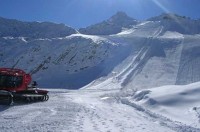
The most snow in Italy above Passo Tonale
In Italy most of the snow in the past week has been in the centre and south of the country causing traffic disruption as far south as Sicily, which has several small ski areas. Campo Felice-Rocca di Cambio in the Abruzzo region, one of Rome’s local ski areas, received 25cm (8 Inches) of new snow whilst Ussita / Frontignano in Marche region got the most in the country with 50cm (20 inches) more snow. It’s still snowing in the major ski areas to the north too though with La Thuile and Courmayeur in the NW of the country receiving 40cm/16 inches and 20cm/8 inches respectively. The Presena Glacier above Passo Tonale and Arabba on the Sella Ronda still have the most snow in the country with 550cm (18 feet) and 480cm (16 feet) respectively. Read more here.
Still More Snow In Scotland (2/13/09)
“This is the first time for many years that we’ve had such great snow at this time of year,” said Marian Austin, Chair of ski-scotland. “All five snowsports areas are reporting alpine conditions with snow fences buried under several feet of snow, and also a surge of interest from people who have not skied or boarded in Scotland before, or at least not for many years.”
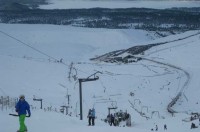
Slovenia Record Snow Depths
As just one example, Mt. Kanin in Slovenia had 9 meters of snow (nearly 30 feet) at height 2230 meters elevation which is the record breaking snow height since they do measurements there. Winter snowfalls accumulations exceeded 11 meters (36 feet of snow) and snow was still falling heavily this week with plenty more to come!

See PDF here.
By Alexandre Aguiar - MetSul Weather Center (Brazil) and ICECAP contributor
Tuesday, February 17th, mid afternoon in Latin America. News wires by the Spanish news agency EFE report a massive collapse of the Wilkins Ice Shelf in Antarctica. The news quickly appeared in the front pages of electronic editions of newspapers all over Latin America and Europe. “Iceberg larger than Hawaii has broken off in Antarctica” was the headline. The news said: “A 14,000 square km shelf of ice, almost twice the area of the Basque Country, has broken off the Wilkins Ice Shelf in the Antarctic. Scientists believe the ice shelf is crumbling as a result of global warming. The Spanish National Research Council (CSIC) has reported today that the resulting giant icebergs are now floating around in the Antarctic Ocean. A team of CSIC scientists have been in the area investigating the impact of the crumbling ice shelf on the ecosystem in the Belinghausen Sea, to the west of the Antarctic peninsula. Over the past two weeks, the scientists have seen the ice shelf on the edge of the Belinghausen Sea recede 550km and have noted that the water temperatures are extraordinarily warm in this area. Experts have warned that the breaking away of this massive ice shelf will ultimately have notable consequences on the sea level.
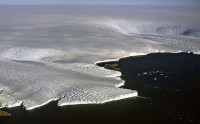
CSIC scientist, Jordi Dachs, reported that his team had found ‘a very high level of biological production’ in the areas where the fragments of ice have gone and that there is ‘abundant fauna, with the largest concentration of humpback whales and leopard seals’ they have seen up until now. ‘We have also found very low levels of CO2 in the sea water’ he continued, ‘suggesting that the increase in sunlight getting through and the elements released by the breaking ice fertilize the water’.”
My suspicion on the news was immediate. How do you detect a 14 thousand square kilometer ice breakdown from a boat. Why weren’t the satellites not showing such a huge event ? Well, later in the day the news had a different version. The Spanish CSIC clarified the collapse was not so large as previously informed. Suddenly, the headlines changed.
But it was not the end of the story. Wednesday, February 18th, mid afternoon in Latin America. News wires by the German news agency DPA report there was not a collapse observed in the Wilkins Ice Shelf. According to DPA, several German researchers assured today that pictures from the German satellite Terrasar and the European Envisat reveal no evidence of a break-up of the 14 thousand kilometers ice platform. The information was released by Professor Angelika Humbert from the University of Munster. Also, Professor Heinrich Miller from the Alfred-Wegener Institute in Bremerhaven dismissed a total collapse. Even the alarmist group Greenpeace said today there was no information on the alleged massive event reported by the Spanish in the South Pole. What was larger than Hawaii, in fact, became an embarrassing ice cube.

See pdf here.
Icecap Note: the peak of the Southern Hemisphere Melt season is still a month ahead. We should not be surprised to see chunks calving off the icesheet or even more cracking in the western Wilkins ice sheet. This is a normal process that has gone on throughout history. It is only now with satellite and funded coastal studies are we documenting these natural processes.
By James M. Taylor, Heartland Institute
Continuing a decade-long trend of declining global temperatures, the year 2008 was significantly colder than 2007, and global temperatures for the year were below the average over the past 30 years. The global temperature data, reported by NASA satellite-based temperature measurements, refuted predictions 2008 would be one of the warmest on record.
Data show 2008 ranked 14th coldest of the 30 years measured by NASA satellite instruments since they were first launched in 1979. It was the coldest year since 2000.
Satellite Precision
NASA satellites uniformly monitor the Earth’s lower atmosphere, which greenhouse gas theory predicts will show the first and most significant effects of human-caused global warming. The satellite-based measurements are uncorrupted by urban heat islands and localized land-use changes that often taint records from surface temperature stations, giving false indications of warming.
The uncorrupted satellite-based temperature measurements refute surface temperature station data finding 2008 to be one of the top 10 warmest years on record. “How can an ‘average year’ in one database appear to be a [top 10] warmest year in another?” asked meteorologist Joe D’Aleo on his International Climate and Environmental Change Assessment Project Web site.
“The global databases of [surface station reports] are all contaminated by urbanization, major station dropout, missing data, bad siting, instruments with known warm biases being introduced without adjustment, and black-box and man-made adjustments designed to maximize [reported] warming,” explained D’Aleo.
Warming Trend Overstated
“The substantial and continuing La Nina cooled the Earth quite a bit in 2008, to the point that it was slightly below the 30-year average [1979-2008] but slightly above the 20-year average [1979-1998],” said John Christy, distinguished professor of atmospheric science and director of the Earth System Science Center at the University of Alabama in Huntsville (UAH).
“From research we have published, and more to come soon, we find that land surface air temperatures misrepresent the actual temperature changes in the deep atmosphere - where the greenhouse effect is anticipated to have its easiest impact to measure. Surface thermometers are affected by many influences, especially surface development, so the bulk atmospheric measurements from satellites offer a straightforward indicator of how much heat is or is not accumulating in the air, for whatever reason,” Christy explained.
“Recent published evidence also supports the long-term trends of UAH as being fairly precise, so the observed rate of warming is noticeably less than that projected by the IPCC ‘Best Estimate’ model simulations which, we hypothesize, are too sensitive to CO2 increases,” Christy added.
See this and much more at the Heartland website here. Read about the upcoming Heartland organized ICCC in New York City March 8-10, 2009 here.
By the AP in the Boston Herald
Former astronaut Harrison Schmitt, who walked on the moon and once served New Mexico in the U.S. Senate, doesn’t believe that humans are causing global warming. “I don’t think the human effect is significant compared to the natural effect,” said Schmitt, who is among 70 skeptics scheduled to speak next month at the International Conference on Climate Change in New York.
Schmitt contends that scientists “are being intimidated” if they disagree with the idea that burning fossil fuels has increased carbon dioxide levels, temperatures and sea levels. “They’ve seen too many of their colleagues lose grant funding when they haven’t gone along with the so-called political consensus that we’re in a human-caused global warming,” Schmitt said.
Dan Williams, publisher with the Chicago-based Heartland Institute, which is hosting the climate change conference, said he invited Schmitt after reading about his resignation from The Planetary Society, a nonprofit dedicated to space exploration. Schmitt resigned after the group blamed global warming on human activity. In his resignation letter, the 74-year-old geologist argued that the “global warming scare is being used as a political tool to increase government control over American lives, incomes and decision making.”
Williams said Heartland is skeptical about the crisis that people are proclaiming in global warming. “Not that the planet hasn’t warmed. We know it has or we’d all still be in the Ice Age,” he said. “But it has not reached a crisis proportion and, even among us skeptics, there’s disagreement about how much man has been responsible for that warming.” Schmitt said historical documents indicate average temperatures have risen by 1 degree per century since around 1400 A.D., and the rise in carbon dioxide is because of the temperature rise. Schmitt also said geological evidence indicates changes in sea level have been going on for thousands of years.
He said smaller changes are related to changes in the elevation of land masses - for example, the Great Lakes are rising because the earth’s crust is rebounding from being depressed by glaciers. Schmitt, who grew up in Silver City and now lives in Albuquerque, has a science degree from the California Institute of Technology. He also studied geology at the University of Oslo in Norway and took a doctorate in geology from Harvard University in 1964. In 1972, he was one of the last men to walk on the moon as part of the Apollo 17 mission. Schmitt said he’s heartened that the upcoming conference is made up of scientists who haven’t been manipulated by politics. Of the global warming debate, he said: “It’s one of the few times you’ve seen a sizable portion of scientists who ought to be objective take a political position and it’s coloring their objectivity.” Read more here.
The Political Philosophy of James HansenBy Roger Pielke Jr.
James Hansen of NASA has written an op-ed for the Guardian that, more than any other piece of his that I’ve seen, expresses his political philosophy. In a phrase, that philosophy can be characterized as “scientific authoritarianism.” Scientific authoritarianism, as I am using it here, holds that political decisions should be compelled by the political preferences of scientists. It is a very strong form of the “linear model” of science and decision making that I discuss in The Honest Broker. Hansen believes that the advice of experts, and specifically his advice alone, should compel certain political outcomes.
He opens his op-ed in the Guardian with this statement: A year ago, I wrote to Gordon Brown asking him to place a moratorium on new coal-fired power plants in Britain. I have asked the same of Angela Merkel, Barack Obama, Kevin Rudd and other leaders. Collectively, Brown, Merkel, Obama and Rudd lead about 500 million people. The idea that one person’s policy views should carry so much weight in democratic societies is an indication that Hansen believes that expertise should carry decisive weight in decisions. Hansen is not even a citizen of Germany, Britain, or the United Kingdom, so the mere fact that he is asking the leaders of these countries to act based on his say-so is an expression of scientific authoritarianism. Rather than making the case for his preferred policy, Hansen’s argument includes his complaint that policy makers have not followed his advice, which apparently, Hansen believes should take precedent over all other views.
Indeed, he dismisses the views of the public as being too poorly informed, too distracted or unsophisticated to contribute to decision making on the climate issue: The public, buffeted by weather fluctuations and economic turmoil, has little time to analyse decadal changes. How can people be expected to evaluate and filter out advice emanating from those pushing special interests? How can people distinguish between top-notch science and pseudo-science?
By contrast, Hansen argues that policy makers cannot be excused for not understanding what the scientists demand: Those who lead us have no excuse - they are elected to guide, to protect the public and its best interests. They have at their disposal the best scientific organisations in the world, such as the Royal Society and the US National Academy of Sciences. Only in the past few years did the science crystallise, revealing the urgency. Hansen’s scientific authoritarianism becomes largely incoherent when he accuses political leaders of “tricking” their citizens when they say that climate policies include plans for the future development and implementation of carbon capture and storage from coal plants: The dirtiest trick that governments play on their citizens is the pretence that they are working on “clean coal” or that they will build power plants that are “capture-ready” in case technology is ever developed to capture all pollutants.
Here Hansen swerves from scientific authoritarianism to megalomania: The trains carrying coal to power plants are death trains. Coal-fired power plants are factories of death. . . The German and Australian governments pretend to be green. When I show German officials the evidence that the coal source must be cut off, they say they will tighten the “carbon cap”. But a cap only slows the use of a fuel - it does not leave it in the ground. When I point out that their new coal plants require that they convince Russia to leave its oil in the ground, they are silent. The Australian government was elected on a platform of solving the climate problem, but then, with the help of industry, it set emission targets so high as to guarantee untold disasters for the young, let alone the unborn. These governments are not green. They are black - coal black. The very notion that the German (or any) government has the obligation to answer to James Hansen is really odd, and one I don’t think I’ve ever seen in any policy analysis on any subject: “When I show, they say. When I point out, they are silent.”
It is a blatant appeal to authority to include the fact that one’s views are not followed as part of the argument for why they should be followed. Hansen must have a pretty well-developed sense of worth to believe that his views should compel governments around the world to listen and follow. On some important aspects of the climate policy issue I agree strongly with Hansen, for instance on the importance of air capture and the feebleness of current policy approaches. But with respect to his approach to climate politics, I could not be more in disagreement. [To head off straw man responses, because I disagree with his political philosophy does not mean that I disagree with any of his policy recommendations.] Climate policy successes will depend on successful processes of democratic governance necessarily involving public participation and support. Scientific authoritarianism, weak or strong, has no role in climate politics. Read post here.
By Alexandre Aguiar - MetSul Weather Center (Brazil) and ICECAP contributor
Today (Thursday) mark the 200 years of the birth of one of the greatest mankind’s scientists. Few people know, but Charles Darwin made very important weather amd climate pattern observations. An AMS paper claims that he should also be credited for the ENSO discovery among other scientists. His observations are useful even to today’s global warming debate. For that reason, I wrote an article especially to ICECAP to mark this date.
A Tribute to Charles Darwin
Today, February 12th, marks the bicentennial of the birth of an extraordinary man. Charles Darwin (12 February 1809 - 19 April 1882) observed and proved that species of life have evolved over time from common ancestors, through a process he called natural selection. His theories caused much controversy and still today, in the 21st century, few people refuse to accept them. The author of Origin of the Species was much more than a naturalist. His contribution to Science reached also the meteorological field and his notes are useful even in today’s global warming debate.
One of the most important meteorological observations from Darwin in Argentina was the periodic frequency of droughts, a pattern that persists nowadays and it is closely related to the PDO and the ENSO variability. University of Buenos Aires’ Professor Eduardo Sierra for many years claim that Argentina experiences dry and wet cycles, related to the PDO, and that a dry period was very probable in the near future, what proven to be true with this current drought.
The current drought in Argentina takes place during one of the longest periods of negative PDO in one hundred years. According to the data from the University of Washington, updated in January 2009, the current period of negative PDO is already 16 months long. Prior to that, since 1900, there were very few periods of the length with consecutive months presenting negative values (20 months from July 1998 to February 2000; 19 months from December 1972 to July 1974; 25 months from July 1970 to July 1972; 28 months from July 1961 to August 1963; 25 months from February 1955 to February 1957). The long period of negative signal of the PDO in the early 60’s coincided also with a severe drought in Argentina, particularly in 1963.

Larger image here.
It is interesting to note that the massive drought described by Charles Darwin in Argentina coincided with a huge drop in the PDO (Pacific Decadal Oscillation), according to the reconstruction of Biondi et all. (North Pacific Decadal Climate Variability Since AD 1661 Journal of Climate, Volume 14, Number 1, pp. 5-10, January 2001)

Larger image here.
The weather observations from 1833 by Charles Darwin constitute and important warning to the near future. Severe droughts not rarely are followed by excessive rain. His notes from 170 years ago in South America, furthermore, reveal the persistence of a climate pattern observed 200 years ago that, despite its recurrence, today is seen as caused by manmade global warming and not nature following its natural path. Charles Darwin took notice of the periodicity of droughts, but nowadays we are forced to read catastrophic claims that ignore history. Those that doubted you have inherited the wind. We have inherited your knowledge. Thank you Mr. Darwin for your overall scientific contribution ! The last two words of the article belong to you.

See the full fascinating tale here.




